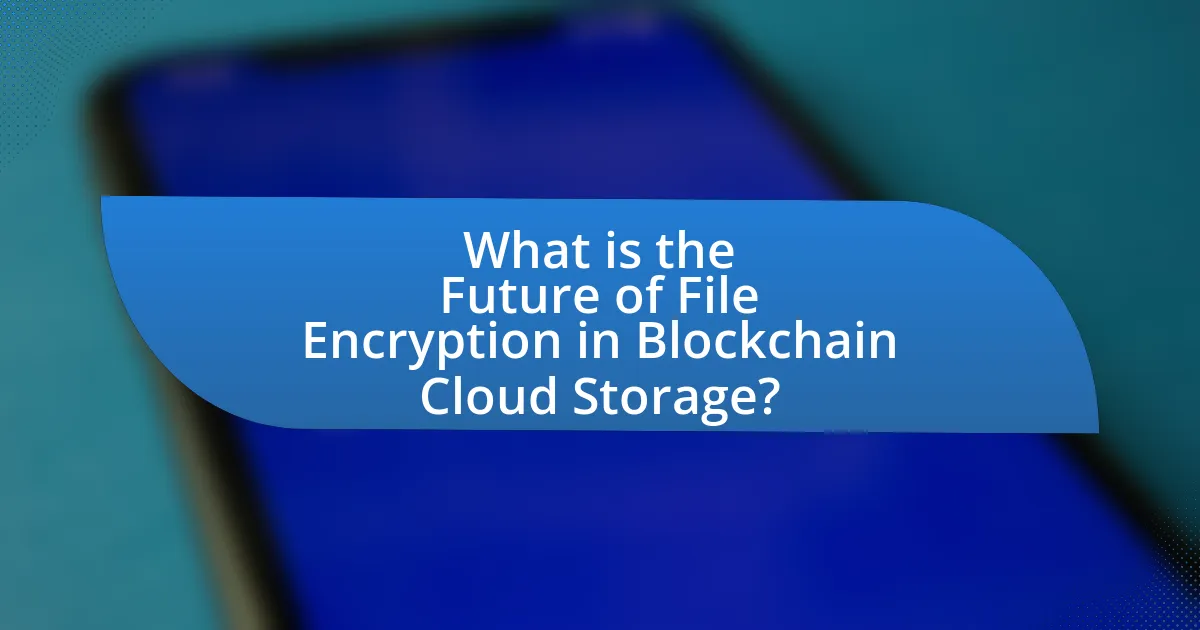The article focuses on the future of file encryption in blockchain cloud storage, emphasizing the importance of enhanced security, privacy, and data integrity through decentralized encryption methods. It discusses various encryption techniques, including symmetric and asymmetric encryption, and highlights their role in protecting user data from unauthorized access and breaches. The article also addresses the challenges organizations face in adopting encryption, the impact of regulatory changes, and emerging trends that shape encryption practices. Additionally, it outlines practical steps users can take to enhance their file encryption and the implications for user privacy and data security in an increasingly digital landscape.

What is the Future of File Encryption in Blockchain Cloud Storage?
The future of file encryption in blockchain cloud storage is expected to enhance security, privacy, and data integrity through decentralized encryption methods. As blockchain technology matures, it will likely integrate advanced cryptographic techniques such as homomorphic encryption and zero-knowledge proofs, allowing users to encrypt data while still enabling computations on that data without exposing it. This evolution is supported by the increasing demand for secure data storage solutions, as evidenced by the rise in cyber threats and data breaches, which have prompted organizations to seek more robust encryption methods. Furthermore, the decentralized nature of blockchain can eliminate single points of failure, making encrypted data more resilient against attacks.
How does file encryption enhance security in blockchain cloud storage?
File encryption enhances security in blockchain cloud storage by ensuring that data is transformed into an unreadable format, accessible only to authorized users with the correct decryption keys. This process protects sensitive information from unauthorized access, even if the data is intercepted or stored on a compromised server. For instance, encryption algorithms like AES (Advanced Encryption Standard) are widely used to secure data, making it nearly impossible for attackers to decipher without the appropriate keys. Additionally, the decentralized nature of blockchain technology complements encryption by distributing data across multiple nodes, further reducing the risk of a single point of failure and enhancing overall data integrity and confidentiality.
What encryption methods are commonly used in blockchain cloud storage?
Common encryption methods used in blockchain cloud storage include symmetric encryption, asymmetric encryption, and hashing. Symmetric encryption, such as AES (Advanced Encryption Standard), utilizes a single key for both encryption and decryption, ensuring fast processing and strong security. Asymmetric encryption, exemplified by RSA (Rivest-Shamir-Adleman), employs a pair of keys—public and private—allowing secure data exchange without sharing the private key. Hashing algorithms like SHA-256 (Secure Hash Algorithm) provide data integrity by generating a fixed-size hash value from input data, making it nearly impossible to reverse-engineer the original data. These methods are integral to maintaining confidentiality, integrity, and authenticity in blockchain cloud storage systems.
How do these methods protect user data?
These methods protect user data by employing advanced encryption techniques that secure files before they are uploaded to the cloud. Specifically, file encryption transforms data into an unreadable format, ensuring that only authorized users with the correct decryption keys can access the original information. Additionally, blockchain technology enhances security by providing a decentralized ledger that records all transactions, making unauthorized access or tampering extremely difficult. This combination of encryption and blockchain integrity safeguards user data against breaches and unauthorized access, as evidenced by the increasing adoption of these technologies in secure cloud storage solutions.
Why is file encryption crucial for blockchain cloud storage?
File encryption is crucial for blockchain cloud storage because it ensures the confidentiality and integrity of sensitive data. In a decentralized environment, where multiple parties access and share data, encryption protects against unauthorized access and data breaches. According to a report by Cybersecurity Ventures, cybercrime damages are projected to reach $10.5 trillion annually by 2025, highlighting the importance of robust security measures like encryption. By encrypting files before they are stored on the blockchain, users can maintain control over their data, ensuring that only authorized individuals can decrypt and access the information. This layer of security is essential for building trust in blockchain cloud storage solutions.
What risks are associated with unencrypted data in cloud storage?
Unencrypted data in cloud storage poses significant risks, including unauthorized access, data breaches, and compliance violations. Unauthorized access can occur when cybercriminals exploit vulnerabilities, leading to sensitive information being exposed. Data breaches are prevalent; according to a report by IBM, the average cost of a data breach in 2021 was $4.24 million, highlighting the financial impact of such incidents. Compliance violations arise when organizations fail to protect personal data, potentially resulting in hefty fines under regulations like GDPR, which can reach up to 4% of annual global revenue. These risks underscore the critical need for encryption to safeguard data stored in the cloud.
How does encryption mitigate these risks?
Encryption mitigates risks in blockchain cloud storage by securing data against unauthorized access and ensuring data integrity. By converting plaintext into ciphertext, encryption protects sensitive information from being intercepted or accessed by malicious actors. For instance, the use of advanced encryption standards, such as AES-256, provides a robust layer of security that makes it computationally infeasible for attackers to decrypt the data without the appropriate keys. Additionally, encryption helps maintain data integrity by allowing users to verify that the data has not been altered during transmission or storage, thus safeguarding against tampering and ensuring trust in the system.
What trends are shaping the future of file encryption in blockchain cloud storage?
Emerging trends shaping the future of file encryption in blockchain cloud storage include the integration of advanced cryptographic techniques, increased focus on user-centric privacy, and the adoption of decentralized identity solutions. Advanced cryptographic techniques, such as homomorphic encryption and zero-knowledge proofs, enable secure data processing without exposing the underlying data, enhancing security and privacy. User-centric privacy is gaining traction as individuals demand more control over their data, leading to the development of encryption methods that prioritize user consent and transparency. Additionally, decentralized identity solutions are being implemented to authenticate users without relying on centralized authorities, further securing access to encrypted files. These trends are supported by the growing need for data security in an increasingly digital world, as evidenced by the rise in data breaches and privacy regulations.
How is the rise of decentralized storage impacting encryption practices?
The rise of decentralized storage is significantly enhancing encryption practices by promoting end-to-end encryption and user-controlled key management. Decentralized storage systems, such as those built on blockchain technology, inherently require robust encryption to secure data across distributed networks. This shift encourages the implementation of advanced cryptographic techniques, such as homomorphic encryption, which allows computations on encrypted data without needing to decrypt it first. Furthermore, decentralized platforms often empower users to manage their own encryption keys, reducing reliance on centralized authorities and minimizing the risk of data breaches. As a result, the adoption of decentralized storage is driving a paradigm shift towards more secure, user-centric encryption methodologies in data management.
What role do regulatory changes play in the evolution of encryption standards?
Regulatory changes significantly influence the evolution of encryption standards by establishing legal frameworks that dictate the requirements for data protection and privacy. For instance, the General Data Protection Regulation (GDPR) in the European Union mandates stringent data security measures, prompting organizations to adopt advanced encryption techniques to comply with these regulations. Additionally, regulatory bodies often update standards in response to emerging threats, which drives innovation in encryption technologies to enhance security. This dynamic relationship between regulation and encryption ensures that standards evolve to meet both legal obligations and the growing sophistication of cyber threats.
How can organizations implement effective file encryption in blockchain cloud storage?
Organizations can implement effective file encryption in blockchain cloud storage by utilizing advanced cryptographic algorithms and integrating them with blockchain technology. This approach ensures that files are encrypted before being uploaded to the cloud, safeguarding data integrity and confidentiality. For instance, using AES (Advanced Encryption Standard) with a key size of 256 bits provides a robust level of security, as it is widely recognized for its strength against brute-force attacks. Additionally, organizations can leverage public-key cryptography to manage encryption keys securely, allowing only authorized users to decrypt the files. This method not only enhances security but also aligns with the decentralized nature of blockchain, where data is distributed across multiple nodes, reducing the risk of single points of failure.
What best practices should organizations follow for encryption implementation?
Organizations should follow several best practices for encryption implementation to ensure data security and compliance. First, they must use strong encryption algorithms, such as AES-256, which is widely recognized for its robustness and is recommended by the National Institute of Standards and Technology (NIST). Second, organizations should implement key management practices that include regular key rotation and secure storage of encryption keys, as improper key management can lead to vulnerabilities. Third, they should ensure that encryption is applied consistently across all data at rest and in transit, minimizing the risk of data exposure. Additionally, organizations must conduct regular audits and assessments of their encryption practices to identify and address potential weaknesses. According to a report by the Ponemon Institute, 60% of organizations that implemented strong encryption reported a significant reduction in data breaches, highlighting the effectiveness of these best practices.
How can organizations assess the effectiveness of their encryption strategies?
Organizations can assess the effectiveness of their encryption strategies by conducting regular audits and penetration testing to evaluate the strength and implementation of encryption protocols. These assessments help identify vulnerabilities and ensure compliance with industry standards such as the General Data Protection Regulation (GDPR) and the Health Insurance Portability and Accountability Act (HIPAA). Additionally, organizations can measure the impact of encryption on data security incidents, analyzing metrics such as the number of breaches or unauthorized access attempts before and after implementing encryption. Studies indicate that organizations employing robust encryption strategies experience significantly fewer data breaches, reinforcing the importance of effective encryption in safeguarding sensitive information.
What challenges do organizations face in adopting file encryption for blockchain cloud storage?
Organizations face several challenges in adopting file encryption for blockchain cloud storage, primarily including complexity, performance issues, regulatory compliance, and user education. The complexity arises from integrating encryption protocols with existing blockchain systems, which can require specialized knowledge and resources. Performance issues may occur as encryption can slow down data access and processing speeds, impacting overall efficiency. Regulatory compliance presents a challenge as organizations must navigate varying legal requirements regarding data protection and encryption standards across different jurisdictions. Lastly, user education is essential, as employees need to understand encryption practices to ensure proper implementation and usage. These challenges collectively hinder the seamless adoption of file encryption in blockchain cloud storage environments.
What technical barriers exist in the integration of encryption technologies?
The technical barriers in the integration of encryption technologies include performance overhead, interoperability issues, and key management challenges. Performance overhead arises because encryption processes can slow down data access and processing speeds, which is critical in environments requiring high throughput, such as blockchain cloud storage. Interoperability issues occur when different encryption standards and protocols do not work seamlessly together, complicating integration across various platforms and systems. Key management challenges involve securely generating, distributing, and storing encryption keys, which is essential for maintaining data security and preventing unauthorized access. These barriers hinder the effective deployment of encryption technologies in blockchain cloud storage solutions.
How can organizations overcome these challenges?
Organizations can overcome challenges in file encryption within blockchain cloud storage by implementing robust encryption protocols and adopting decentralized storage solutions. By utilizing advanced encryption standards, such as AES-256, organizations can ensure data confidentiality and integrity. Furthermore, leveraging blockchain technology allows for immutable records of data access and modifications, enhancing security. A study by the International Journal of Information Management highlights that organizations employing decentralized storage can significantly reduce the risk of data breaches, as data is not stored in a single location. This combination of strong encryption and decentralized architecture provides a comprehensive approach to mitigating risks associated with file encryption in blockchain cloud storage.
What are the future implications of file encryption in blockchain cloud storage for users?
File encryption in blockchain cloud storage will enhance user data security and privacy, making it increasingly difficult for unauthorized access and data breaches. As blockchain technology inherently provides decentralized storage, the integration of file encryption ensures that even if data is intercepted, it remains unreadable without the decryption key. This dual-layer security model is expected to foster greater user trust in cloud storage solutions, as evidenced by a 2021 report from Cybersecurity Ventures predicting that cybercrime damages will reach $10.5 trillion annually by 2025, highlighting the critical need for robust security measures. Furthermore, as regulatory frameworks around data protection tighten globally, users will benefit from compliance with standards such as GDPR, which mandates stringent data protection practices. Thus, the future implications of file encryption in blockchain cloud storage will likely include enhanced security, increased user trust, and improved compliance with data protection regulations.
How will advancements in encryption technology affect user privacy?
Advancements in encryption technology will significantly enhance user privacy by providing stronger protection against unauthorized access to personal data. Enhanced encryption methods, such as quantum encryption and advanced symmetric algorithms, create more complex keys that are harder to crack, thereby safeguarding sensitive information from cyber threats. For instance, the implementation of end-to-end encryption in messaging applications has already demonstrated a marked decrease in data breaches, as seen in the rise of secure platforms like Signal and WhatsApp, which utilize robust encryption protocols to protect user communications. This trend indicates that as encryption technology evolves, users can expect increased confidentiality and security of their data in various digital environments, including blockchain cloud storage solutions.
What should users consider when choosing a blockchain cloud storage provider?
Users should consider security features, data privacy policies, and scalability when choosing a blockchain cloud storage provider. Security features include encryption methods, access controls, and the provider’s track record against breaches. Data privacy policies should clarify how user data is handled, stored, and shared, ensuring compliance with regulations like GDPR. Scalability is essential for accommodating future data growth and varying storage needs, which can be assessed through the provider’s infrastructure and service offerings. These factors are critical as they directly impact the safety, accessibility, and longevity of stored data in a blockchain environment.
What practical steps can users take to enhance their file encryption in blockchain cloud storage?
Users can enhance their file encryption in blockchain cloud storage by implementing strong encryption algorithms, utilizing multi-factor authentication, and regularly updating their encryption keys. Strong encryption algorithms, such as AES-256, provide robust security for files stored in the cloud, ensuring that unauthorized access is minimized. Multi-factor authentication adds an additional layer of security by requiring users to verify their identity through multiple methods, making it harder for attackers to gain access. Regularly updating encryption keys prevents potential breaches from compromised keys, as outdated keys can be more vulnerable to attacks. These steps collectively strengthen the security of files in blockchain cloud storage, safeguarding sensitive information against unauthorized access.


